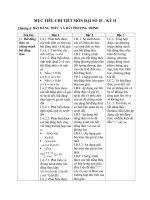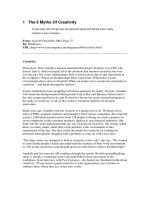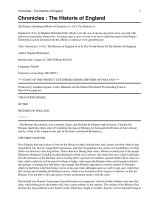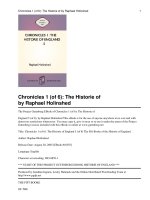- Trang chủ >>
- Mầm non - Tiểu học >>
- Lớp 5
5 6 words of freedom the US constitution
Bạn đang xem bản rút gọn của tài liệu. Xem và tải ngay bản đầy đủ của tài liệu tại đây (3.4 MB, 10 trang )
Fascinating Facts
• At the Constitutional Convention, Benjamin Franklin’s
health was so poor that he had to be carried to the
sessions in a chair. Still, he rarely missed a session.
• George Washington signed the Constitution but not the
Declaration of Independence. At the time the declaration
was signed, he was in New York serving as the
commander of the Continental Army.
• More than half of the delegates to the Constitutional
Convention were lawyers or had studied law.
Genre
Nonfiction
Comprehension Skill
Draw Conclusions
Text Features
• Captions
• Headings
Scott Foresman Social Studies
ISBN 0-328-14895-4
ì<(sk$m)=beijfa< +^-Ä-U-Ä-U
by Kristin Cashore
The leaders who met at the Constitutional Convention
in 1787 had many different opinions about how the
country should be run. Fortunately, they were willing to
make compromises. In this book you will read about
some of the people who came together to bring the
Constitution to life.
Vocabulary
Write to It!
Have you ever made a compromise with someone? In
the compromise, what did you have to give up? What
did the other person have to give up? What made the
compromise worthwhile? Write one paragraph in which
you explain the compromise you made and why you
made it.
delegate
compromise
Write your compromise on a separate sheet of paper.
legislative branch
executive branch
judicial branch
checks and balances
ratify
Photographs
Every effort has been made to secure permission and provide appropriate credit for photographic material. The publisher deeply
regrets any omission and pledges to correct errors called to its attention in subsequent editions.
by Kristin Cashore
Unless otherwise acknowledged, all photographs are the property of Scott Foresman, a division of Pearson Education.
Photo locators denoted as follows: Top (T), Center (C), Bottom (B), Left (L), Right (R), Background (Bkgd)
ISBN: 0-328-14895-4
Copyright © Pearson Education, Inc.
All Rights Reserved. Printed in the United States of America. This publication is protected
by Copyright, and permission should be obtained from the publisher prior to any prohibited
reproduction, storage in a retrieval system, or transmission in any form by any means,
electronic, mechanical, photocopying, recording, or likewise. For information regarding
permission(s), write to: Permissions Department, Scott Foresman, 1900 East Lake Avenue,
Glenview, Illinois 60025.
1 2 3 4 5 6 7 8 9 10 V0G1 14 13 12 11 10 09 08 07 06 05
Opener: ©Gary Randall/Getty Images
2 ©The Granger Collection, NY
4 ©The Granger Collection, NY
5 ©The Granger Collection, NY
Editorial Offices: Glenview, Illinois • Parsippany, New Jersey • New York, New York
6 ©Library of Congress
7 ©The Granger Collection,
NY Offices: Needham, Massachusetts • Duluth, Georgia • Glenview, Illinois
Sales
8 ©The Corcoran Gallery of Art/Corbis
Coppell,
Texas • Sacramento, California • Mesa, Arizona
9 ©The Granger Collection, NY
10 ©The Granger Collection, NY
11 ©The Granger Collection, NY
12 ©The Granger Collection, NY
13 ©Bequest of Winslow Warren/Bridgeman Art Library
14 ©The Granger Collection, NY
Many of our nation’s early leaders met at
the Constitutional Convention in 1787.
The United States Constitution
In 1783 the American Revolution came to an end. However,
the end of the war did not bring an end to the troubles that the
young nation faced.
In 1781 the Continental Congress wrote the Articles of
Confederation. With the Articles, American leaders established
a weak central government with one branch—Congress. They
remembered what it was like to suffer under British rule. They
did not want America’s central government to be strong and
tyrannous, like Britain’s was.
The powers of Congress were so limited that, for example, it
could not tax the people. This meant that Congress had little money
to run the country. It also could not make trade laws with other
nations. Therefore, the United States was unable to create strong
trade relations with other nations. Because of the weak central
government, our nation was neither stable nor strong.
When the delegates to the Constitutional Convention met in
Philadelphia in 1787, they knew that the United States needed a
more effective government. Some wanted the government to be
strong so that the country would be stable. Others wanted the
government to be weak to protect the rights of the people.
After a lot of debate and many compromises, the delegates
wrote the United States Constitution. The Constitution created
a strong central government with three branches: the legislative
branch, the executive branch, and the judicial branch. The
Constitution, however, also protected the people by creating
checks and balances and leaving many powers to the states. It
was also decided that the Constitution could also be amended.
The people who wrote the Constitution did not always agree, but
in their wisdom, they came together and cooperated. Each person’s
contribution was important.
2
3
George Washington: The Leader of the
Constitutional Convention
The delegates to the Constitutional Convention were
lawyers, soldiers, businesspeople, and merchants. More than
half of the delegates had fought in the Revolutionary War, and
many had helped write their states’ constitutions. But even
among these distinguished people, one stood out as a leader:
George Washington.
Washington was a popular man. Against all odds, he had led the
American troops to victory in the Revolutionary War. Many admired
and respected him. Washington was a true American Patriot. He
did not want personal power. He wanted what was best for the
people. Washington put
his own glory aside and
worked instead for the
good of the country and
its citizens.
George Washington wanted
what was best for the
people, not what was best
for himself.
4
George Washington was admired by many during the Revolutionary War.
Washington was one of the people who called for the
Constitutional Convention. He could see that the government
of the United States was not effective. Washington knew that
the states would not work well together unless the central
government was made stronger. He favored a new Constitution
and a more powerful national government.
The delegates unanimously elected Washington as the leader
of the Constitutional Convention. For many of the delegates,
Washington was a symbol of dignity, stability, authority, and
restraint. They wanted a government that was very much like
Washington, strong but protective of the rights of the people. His
presence at the convention was essential. With his leadership
the delegates were able to come together, put aside their
differences, and create a government for the good of the people.
5
James Madison:
“The Father of the Constitution”
James Madison of Virginia contributed greatly to the Constitution.
Like George Washington, Madison believed in a strong central
government. He came to the convention with a unique plan for
the nation. He had worked out this plan with the help of the other
Virginia delegates. It was called the Virginia Plan.
Madison’s plan involved throwing out the Articles of
Confederation and establishing a different kind of government.
Under the Articles of Confederation, Congress was unicameral,
which means it had only one house. The Virginia Plan featured a
legislature that would be bicameral, or having two houses.
This is the first page of James Madison’s Virginia Plan, which became,
in large part, the basis for the United States Constitution.
Madison’s plan also called for
three branches of government,
none of which were allowed
to become too powerful.
It supported the idea of a
strong national government
to hold the states together.
The delegates rejected
many of the details of
Madison’s Virginia Plan, but
in the end, his key ideas were
included in the Constitution.
The Constitution created a
republic with three branches
of government and a system
of checks and balances
to keep each branch from
becoming too strong.
Madison was one of the
most regular speakers at
the convention. His Virginia
James Madison is called
Plan was very influential.
“The Father of the Constitution.”
Madison also contributed to
the wording of the Constitution and kept thorough notes on the
debates that took place. Madison was exceptionally active in
the making of the Constitution.
7
In his lifetime, Franklin was a writer, a scientist, an inventor,
an ambassador, and a political leader. He had great curiosity,
an adventurous spirit, and a love of knowledge. The delegates
respected him, and he was often able to soothe their tempers when
arguments broke out. Franklin knew the wisdom of compromise.
Franklin was not happy about everything in the final
Constitution, but he signed the document anyway. In his own
words, “I expect no better because I am not sure, that it is not
the best.” He encouraged other delegates who did not like the
Constitution to sign it. He knew that it would not be easy to build
the government that they had designed on paper, but he also
believed that nothing was more worth trying for.
Benjamin Franklin believed in a strong
national government.
Benjamin Franklin: “The Sage of the
Constitutional Convention”
A sage is a wise person who is honored for his or her experience
and judgment. Benjamin Franklin, a delegate from Pennsylvania,
was called “The Sage of the Constitutional Convention.”
Like Washington and Madison, Franklin believed that the
country needed a strong central government. At the age of
eighty-one, he was the oldest delegate to the convention. He
contributed his wisdom and his experience to the framing of the
new Constitution.
8
In addition to his other
occupations, Benjamin
Franklin was an
inventor. Some of his
many inventions include
the lightning rod, the
Franklin stove, and
bifocal glasses.
Alexander Hamilton:
“The Champion of the Constitution”
New York delegate Alexander Hamilton believed that the
United States needed a stronger central government. However,
Hamilton’s ideas were more extreme than those of most of the
other delegates.
Hamilton believed that senators and the leader of the
executive branch should serve for life. He also thought that
state governments were unnecessary, and that all power should
be given to the central government. Most of the delegates
disagreed with Hamilton’s ideas. They felt that the strong
government Hamilton wanted was too similar to the tyrannous
government of Britain.
Alexander
Hamilton wanted
a strong central
government.
Alexander Hamilton,
James Madison, and
John Jay wrote a
collection of essays
called The Federalist
in support of
the Constitution.
10
Hamilton was not completely happy with the Constitution. He
was afraid that the new government would be too weak to last.
However, he knew the importance of compromise, and he knew
that the Constitution was better than the Articles of Confederation.
He put his own opinions aside and signed the document.
Hamilton did not stop there. He wrote essays encouraging the
states to ratify the Constitution. He spoke out in support of the
document. One after another, the states agreed to ratify it. With
the help of leaders like Alexander Hamilton, people who were
brave enough to put their own opinions aside, the Constitution
became law.
11
George Mason proposal to include a bill of
rights in the Constitution was defeated.
Mason was not the only person who spoke out for the
rights of the people. Thomas Jefferson was not a delegate
to the Constitutional Convention. He was in Europe, serving
as the American Minister to France. However, Jefferson made
it known that while he was in favor of a strong government,
he also believed that the Constitution needed a bill of rights.
In fact, many delegates and many citizens across the nation
voiced concern about this. Mercy Otis Warren, a writer from
Massachusetts, wrote a criticism of the Constitution. One of her
main complaints was that it contained no bill of rights.
So many people wanted a bill of rights that most state
governments insisted, as a condition of ratification, that the first
Congress add a bill of rights that would guarantee freedom of
religion, freedom of speech, freedom of the press, and a number
of other basic freedoms.
Other Voices
Washington, Madison, Franklin, and Hamilton were all in favor
of a strong national government. However, there were plenty of
delegates at the Constitutional Convention who were not. George
Mason, another Virginia delegate, was one of them.
Mason voiced concern that a strong government would lead
to a President who was like a king. He worried that the central
government would have too much power over the states. He also
worried that a strong government would not protect the rights of
the people, such as freedom of the press and freedom of religion.
12
Mercy Otis
Warren supported
individual rights.
13
Cooperation and Compromise
Another important voice belonged
to Roger Sherman from Connecticut.
Sherman came up with one of the
most important compromises in
the Constitution.
Many delegates disagreed about
the number of representatives each
state should have in Congress.
The larger states thought that
the number should be based on
population. This meant that Virginia,
Roger Sherman came up with
the Great Compromise.
for example, would have more
representatives than Delaware.
However, the smaller states were afraid of losing what little power
they had. They insisted that every state have the same number of
representatives, regardless of population.
Roger Sherman came up with a solution. He suggested that
Congress should have two houses. The number of members in
one house of Congress should depend on state population, while
the number of members in the other house should be the same
for every state. After much debate the delegates agreed. The
agreement became known as the Great Compromise. Because of
Roger Sherman’s suggestion, the delegates were able to proceed
with their task of creating the Constitution.
14
On September 17, 1787, thirty-nine of the fifty-five delegates
to the Constitutional Convention signed the Constitution. Some
of the delegates, such as George Washington and Benjamin
Franklin, were among the most famous people in the country.
Others, such as Roger Sherman, were less well-known people
whose contributions were equally important. For the signers of
the Constitution, the document was a triumph of cooperation
and compromise. Almost all of them had concerns about the
Constitution, but they were determined to create the greatest
government they could. They knew that the Constitution was the
very best they could do and hoped that it would build a strong
and free nation.
By late summer of 1788, the Constitution had been ratified by
eleven states and became law. Slowly, our country formed and
grew around its Constitution.
The Constitution that worked for our young nation long ago still
works today. For this accomplishment we must thank the leaders
of the Constitutional Convention who came together in the spirit
of strength, liberty, cooperation, and compromise.
The United States Constitution was signed on September 17, 1787.
The leaders who met at the Constitutional Convention
in 1787 had many different opinions about how the
country
should be run. Fortunately, they were willing to
Glossary
make
compromises.
In thisa book
youinwill
readeach
about
checks
and balances
system
which
some of
the people
who came
together
bringofthe
branch
of government
checks
the to
power
Constitution
to life.
the other
branches
compromise a deal in which each side gives up
something in order
to reach an agreement
Vocabulary
Write to It!
Have you ever made a compromise with someone? In
the compromise, what did you have to give up? What
did the other person have to give up? What made the
compromise worthwhile? Write one paragraph in which
you explain the compromise you made and why you
made it.
delegate
delegate a representative
executive branch compromise
the part of the government
that is in charge
of enforcing
our nation’s laws
legislative
branch
Write your compromise on a separate sheet of paper.
judicial branch executive
the part ofbranch
the government that
is in charge of interpreting our nation’s laws
judicial branch
legislative branch the part of the government
checks and balances
that makes our nation’s laws
ratify
ratify to approve
Photographs
Every effort has been made to secure permission and provide appropriate credit for photographic material. The publisher deeply
regrets any omission and pledges to correct errors called to its attention in subsequent editions.
Unless otherwise acknowledged, all photographs are the property of Scott Foresman, a division of Pearson Education.
Photo locators denoted as follows: Top (T), Center (C), Bottom (B), Left (L), Right (R), Background (Bkgd)
ISBN: 0-328-14895-4
Copyright © Pearson Education, Inc.
All Rights Reserved. Printed in the United States of America. This publication is protected
by Copyright, and permission should be obtained from the publisher prior to any prohibited
reproduction, storage in a retrieval system, or transmission in any form by any means,
electronic, mechanical, photocopying, recording, or likewise. For information regarding
permission(s), write to: Permissions Department, Scott Foresman, 1900 East Lake Avenue,
Glenview, Illinois 60025.
1 2 3 4 5 6 7 8 9 10 V0G1 14 13 12 11 10 09 08 07 06 0516
Opener: ©Gary Randall/Getty Images
2 ©The Granger Collection, NY
4 ©The Granger Collection, NY
5 ©The Granger Collection, NY
6 ©Library of Congress
7 ©The Granger Collection, NY
8 ©The Corcoran Gallery of Art/Corbis
9 ©The Granger Collection, NY
10 ©The Granger Collection, NY
11 ©The Granger Collection, NY
12 ©The Granger Collection, NY
13 ©Bequest of Winslow Warren/Bridgeman Art Library
14 ©The Granger Collection, NY









